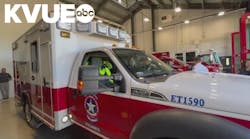During the past year, the museum has focused its attention on the centennial celebration of the Great Baltimore Fire of 1904. As a testament to the brave firefighters who conquered the inferno and the resilient citizens who brought Baltimore back from total disaster, the museum has prepared a grand, multi-faceted celebration that began with coach tours of the burnt district earlier this year.
Visitors are treated to a new exhibit featuring an acoustic-guide walking tour, never-before-seen photos, maps, uniforms, personal accounts of the blaze, pieces of debris and other items that will illustrate that event and the fortitude of the people who lived through it.
The museum has also updated its existing film on The Great Fire, which now includes images filmed by the Edison Institute the day after the conflagration. Available at the museum are two new books about the fire told from the perspective of the firefighters: Fire Department Operations – A Technical Report: The Great Baltimore Fire by Gary Frederick and No Reason to Burn! The Story of Great Baltimore Fire by George Welden.
Stephen Heaver Sr. and his son, Stephen Jr., founded the museum in 1971. When Heaver Jr. was 12, his father bought the first piece of equipment, a 1928 American LaFrance pumper; a second piece, a 1922 Ahrens-Fox; and a third piece, a 1926 Mack Bulldog. They had a variety of shops and storage facilities and moved from one place to another, while searching for the ideal spot. They always dreamed of starting a museum.
In 1970, they visited the Long Island Old Fire Engine Museum, owned and operated by Nicholas Dionisio, who told them that he was selling his collection so that he could retire and travel. Heaver Sr. bought his hand and horse-drawn collection, and combined it with his collection, which was almost all motorized. A warehouse-size building, measuring 20,000 square feet, was built and the home of the non-profit Fire Museum of Maryland was established in September 1971.
Today, there is an excellent representation of periods and styles, focusing strongly on the late horse-drawn and early motorized. The museum has a working fire alarm telegraph office that is representative of the major types found in firehouses in the 1940s. With a running board and buttons, it includes a switchboard and fire boxes. It also includes a watch desk.
The Heavers gave serious thought to the origin, restoration and authenticity of each piece. All are unique. For instance, an early hand-drawn engine was built in 1853. It was made from mahogany, and is notable for its large wheels and hand-pumping engine. Cinderella’s coach, on the other hand, might have been the inspiration for the Marion Hose No. 2 model. It has five oil lamps to light the way. No seats were provided, with only handles to pull it to the scene.
In the earlier days of hand-drawn equipment, the men took great pride in the appearance of their equipment. Many handcarvings decorate the sides of engines. Polished brass shone in contrast with the large wooden wheels. Colored glass framed the lanterns. Silver and nickel plates were not uncommon.
Bells jingled and “Fire!” was shouted through brass trumpets as the firemen responded to the need of their day. Green, blue and yellow were familiar engine colors in those days, as it was not until more recent times that red became the predominant color. There was usually a fire engine for parades and one for fires. Parade days featured contests among the companies in which each would rush to be first to hook up to the water supply to compete for the highest flow of water.
If you thought seatbelts were a relatively new invention, a visit to the museum will inform you that they came in to use by the end of the 19th century. They proved a necessity in the late 1800s, when the steamer, considered the most colorful of firefighting equipment, was introduced. The steamer, or steam-pumping engine, was usually drawn by two or three enormous horses, and seatbelts became standard equipment for firemen as the galloping horses pulled steamers to the scene of the fire.
With the rise in building height after the Civil War, the need for higher ladders grew. Among the pioneers in this development was Daniel Hayes, who in 1870 perfected the ideas of mounting an extension ladder with a screw and gear mechanism. One of a few Hayes extension ladders remaining, a 55-foot aerial model, is included at the museum.
Eventually, the horse was unharnessed and replaced by a front-wheel-drive tractor. As internal combustion engines began to prove their merit, fire chiefs looked for ways to conserve the lives of old steamer engines. The answer to the problem came in 1912, when Walter Christie invented a four-cylinder front wheel drive to attach to the front end of the steamer. Horses were replaced by the Christies, and the steamer’s life extended another five to 20 years.
In terms of the future collection, the museum is searching for a 1970s or 1980s aerial platform with an articulating boom that has original paint. The museum wishes to show the transition into the motorized period and the most significant apparatus design of the last half of the 20th century.
Today, the museum continues to focus on how a collection of firefighting equipment can be used to teach people not only about history, but also about modern fire services and safety. School field trips, story time, fire safety house tours, craft days, movie days, facility rentals and special events are just a few of the opportunities awaiting guests. A good time is guaranteed in the Discovery Room, where children sit behind the wheel of a 1938 fire engine dressed up as firefighters!
Become a member of the Red Suspender Club and help support a legacy for generations to come. All gifts support the museum and its collection. Checks should be made payable to: Fire Museum of Maryland, 1301 York Road, Lutherville, MD 21093. Attn: Red Suspender Club. The museum is open from 11 A.M. to 4 P.M. Saturdays from March through December and Tuesday through Saturday from June through August. Group tours are offered year-round. Questions: Telephone 410-321-7500 or e-mail [email protected].
Debbie Brown is public affairs manager for the Fire Museum of Maryland.







